Strategic Analysis and Planning Report - Course Name, Semester
VerifiedAdded on 2021/10/29
|15
|4108
|29
Report
AI Summary
This report provides a detailed analysis of strategic analysis and planning, exploring the concept of biculturalism and its impact on society. It examines the historical context of biculturalism in New Zealand, focusing on the relationship between Maori and non-Maori populations, and discusses business strategies for achieving bicultural partnerships. The report further delves into the integration of Traditional Ecological Knowledge with the Rakiura Maori, outlining strategies for participation, partnership, and protection. It also includes practical approaches for knowledge transfer and a case study on Moana New Zealand, analyzing the impact of the Treaty of Waitangi on the company. The report covers both internal and external factors affecting the business and explores financial and non-financial objectives.
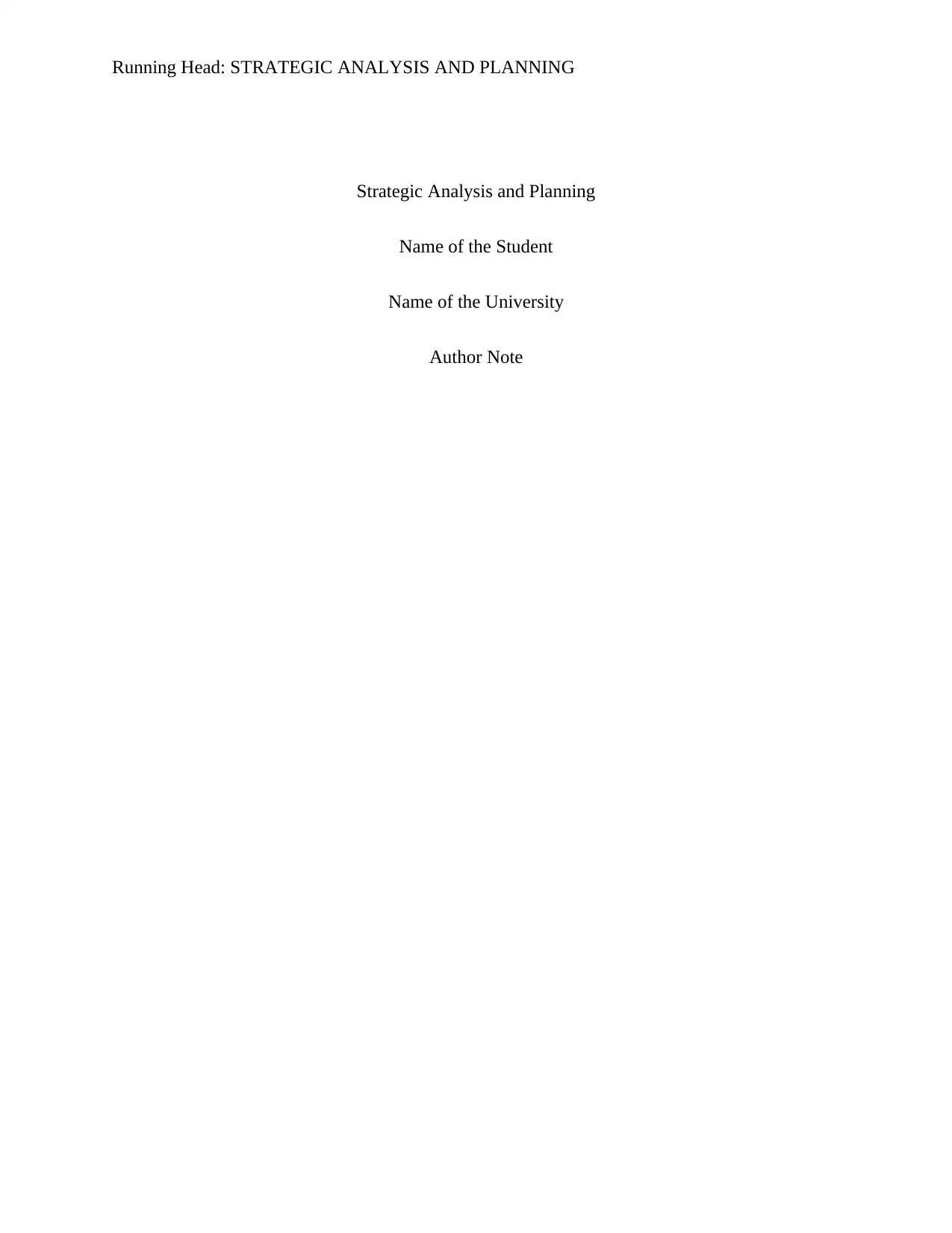
Running Head: STRATEGIC ANALYSIS AND PLANNING
Strategic Analysis and Planning
Name of the Student
Name of the University
Author Note
Strategic Analysis and Planning
Name of the Student
Name of the University
Author Note
Paraphrase This Document
Need a fresh take? Get an instant paraphrase of this document with our AI Paraphraser
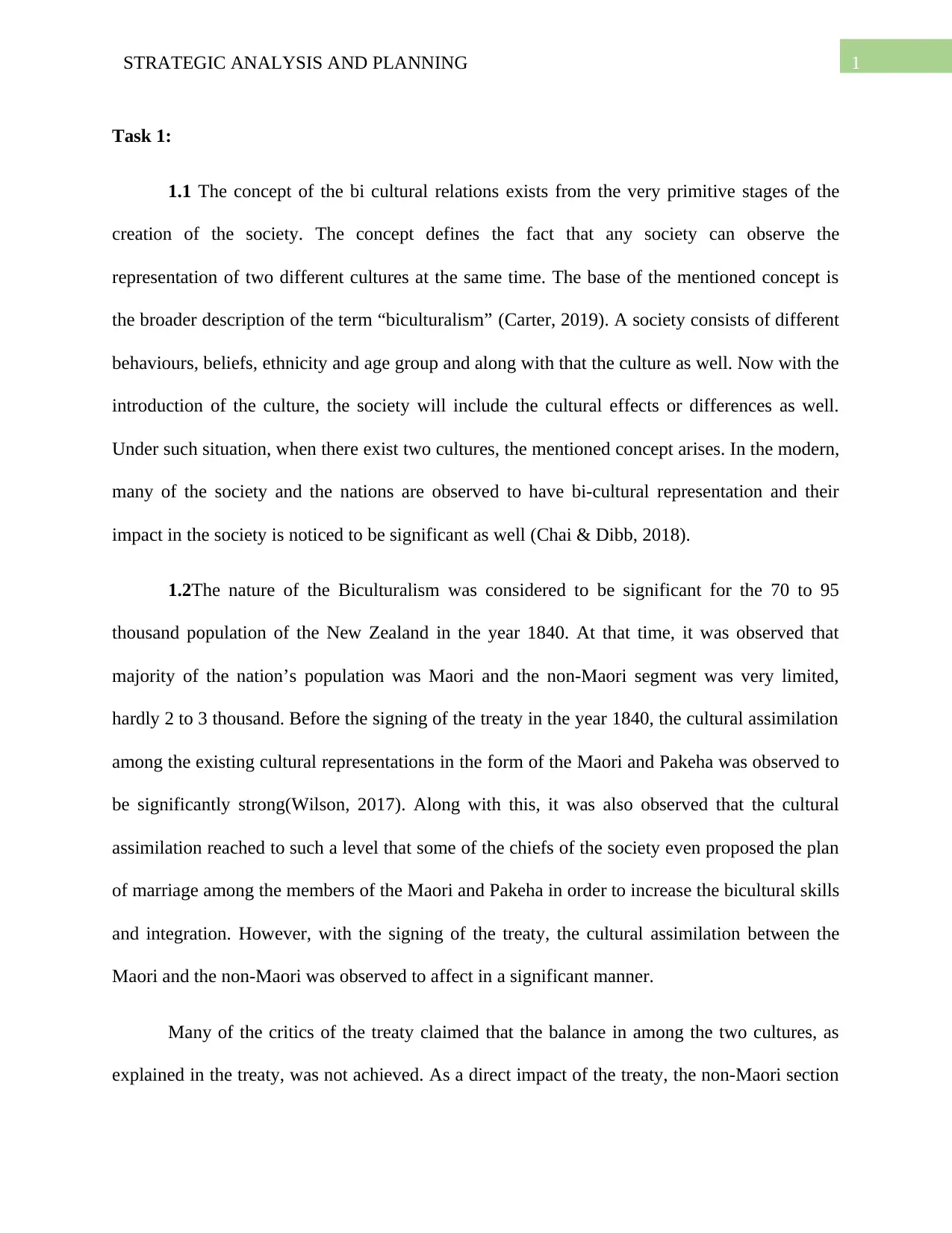
1STRATEGIC ANALYSIS AND PLANNING
Task 1:
1.1 The concept of the bi cultural relations exists from the very primitive stages of the
creation of the society. The concept defines the fact that any society can observe the
representation of two different cultures at the same time. The base of the mentioned concept is
the broader description of the term “biculturalism” (Carter, 2019). A society consists of different
behaviours, beliefs, ethnicity and age group and along with that the culture as well. Now with the
introduction of the culture, the society will include the cultural effects or differences as well.
Under such situation, when there exist two cultures, the mentioned concept arises. In the modern,
many of the society and the nations are observed to have bi-cultural representation and their
impact in the society is noticed to be significant as well (Chai & Dibb, 2018).
1.2The nature of the Biculturalism was considered to be significant for the 70 to 95
thousand population of the New Zealand in the year 1840. At that time, it was observed that
majority of the nation’s population was Maori and the non-Maori segment was very limited,
hardly 2 to 3 thousand. Before the signing of the treaty in the year 1840, the cultural assimilation
among the existing cultural representations in the form of the Maori and Pakeha was observed to
be significantly strong(Wilson, 2017). Along with this, it was also observed that the cultural
assimilation reached to such a level that some of the chiefs of the society even proposed the plan
of marriage among the members of the Maori and Pakeha in order to increase the bicultural skills
and integration. However, with the signing of the treaty, the cultural assimilation between the
Maori and the non-Maori was observed to affect in a significant manner.
Many of the critics of the treaty claimed that the balance in among the two cultures, as
explained in the treaty, was not achieved. As a direct impact of the treaty, the non-Maori section
Task 1:
1.1 The concept of the bi cultural relations exists from the very primitive stages of the
creation of the society. The concept defines the fact that any society can observe the
representation of two different cultures at the same time. The base of the mentioned concept is
the broader description of the term “biculturalism” (Carter, 2019). A society consists of different
behaviours, beliefs, ethnicity and age group and along with that the culture as well. Now with the
introduction of the culture, the society will include the cultural effects or differences as well.
Under such situation, when there exist two cultures, the mentioned concept arises. In the modern,
many of the society and the nations are observed to have bi-cultural representation and their
impact in the society is noticed to be significant as well (Chai & Dibb, 2018).
1.2The nature of the Biculturalism was considered to be significant for the 70 to 95
thousand population of the New Zealand in the year 1840. At that time, it was observed that
majority of the nation’s population was Maori and the non-Maori segment was very limited,
hardly 2 to 3 thousand. Before the signing of the treaty in the year 1840, the cultural assimilation
among the existing cultural representations in the form of the Maori and Pakeha was observed to
be significantly strong(Wilson, 2017). Along with this, it was also observed that the cultural
assimilation reached to such a level that some of the chiefs of the society even proposed the plan
of marriage among the members of the Maori and Pakeha in order to increase the bicultural skills
and integration. However, with the signing of the treaty, the cultural assimilation between the
Maori and the non-Maori was observed to affect in a significant manner.
Many of the critics of the treaty claimed that the balance in among the two cultures, as
explained in the treaty, was not achieved. As a direct impact of the treaty, the non-Maori section

2STRATEGIC ANALYSIS AND PLANNING
of the society was observed to grow in a significant manner and they became the dominant
segment in the society. In spite of the principles in place for the protection of the Maori, the non-
Maori culture along with the British section of the society was observed to overcome the impact
and power of the natives(Wilson, 2017). As a result, the society was observed to turn into mono-
cultural. However, it is observed that many of the researchers of the Maori culture were able to
comment on the significant difference of the cultures of the Maori and Non Maori by stating that
the New Zealand is one major country which in itself has two different nations in form of Maori
and Non-Maori. Hence many of the researchers also claimed it to be bi-nationalism instead of
biculturalism.
1.3 The strategies for the business implementation in order achieve the bi-cultural
partnership in the business activity are majorly the improvement in the cross cultural assimilation
among the employees of the organization and the improvement of the business network. Apart
from these two, the business expansion and the divisional organizational structure is an important
base for the bi-cultural assimilation where the same company will have national subsidiaries and
the interaction among the employees of the different subsidiaries will be significant in increasing
the cultural integration. The cross cultural assimilation can be achieved by the cultural training
which will include activities like language training, societal integration and increased
involvement of the employees who are considered as the outsiders of the cultures to the host
nation culture. The improvement in the business network will be significantly helpful for the
business organizations in getting integrated to different cultures.
1.4 The strategies adopted for the bi cultural partnership between the Traditional
Ecological Knowledge and Rakiura Maori in the southern parts of the New Zealand were the
formation of the trust among the parties, effective communication among them regarding the
of the society was observed to grow in a significant manner and they became the dominant
segment in the society. In spite of the principles in place for the protection of the Maori, the non-
Maori culture along with the British section of the society was observed to overcome the impact
and power of the natives(Wilson, 2017). As a result, the society was observed to turn into mono-
cultural. However, it is observed that many of the researchers of the Maori culture were able to
comment on the significant difference of the cultures of the Maori and Non Maori by stating that
the New Zealand is one major country which in itself has two different nations in form of Maori
and Non-Maori. Hence many of the researchers also claimed it to be bi-nationalism instead of
biculturalism.
1.3 The strategies for the business implementation in order achieve the bi-cultural
partnership in the business activity are majorly the improvement in the cross cultural assimilation
among the employees of the organization and the improvement of the business network. Apart
from these two, the business expansion and the divisional organizational structure is an important
base for the bi-cultural assimilation where the same company will have national subsidiaries and
the interaction among the employees of the different subsidiaries will be significant in increasing
the cultural integration. The cross cultural assimilation can be achieved by the cultural training
which will include activities like language training, societal integration and increased
involvement of the employees who are considered as the outsiders of the cultures to the host
nation culture. The improvement in the business network will be significantly helpful for the
business organizations in getting integrated to different cultures.
1.4 The strategies adopted for the bi cultural partnership between the Traditional
Ecological Knowledge and Rakiura Maori in the southern parts of the New Zealand were the
formation of the trust among the parties, effective communication among them regarding the
⊘ This is a preview!⊘
Do you want full access?
Subscribe today to unlock all pages.

Trusted by 1+ million students worldwide
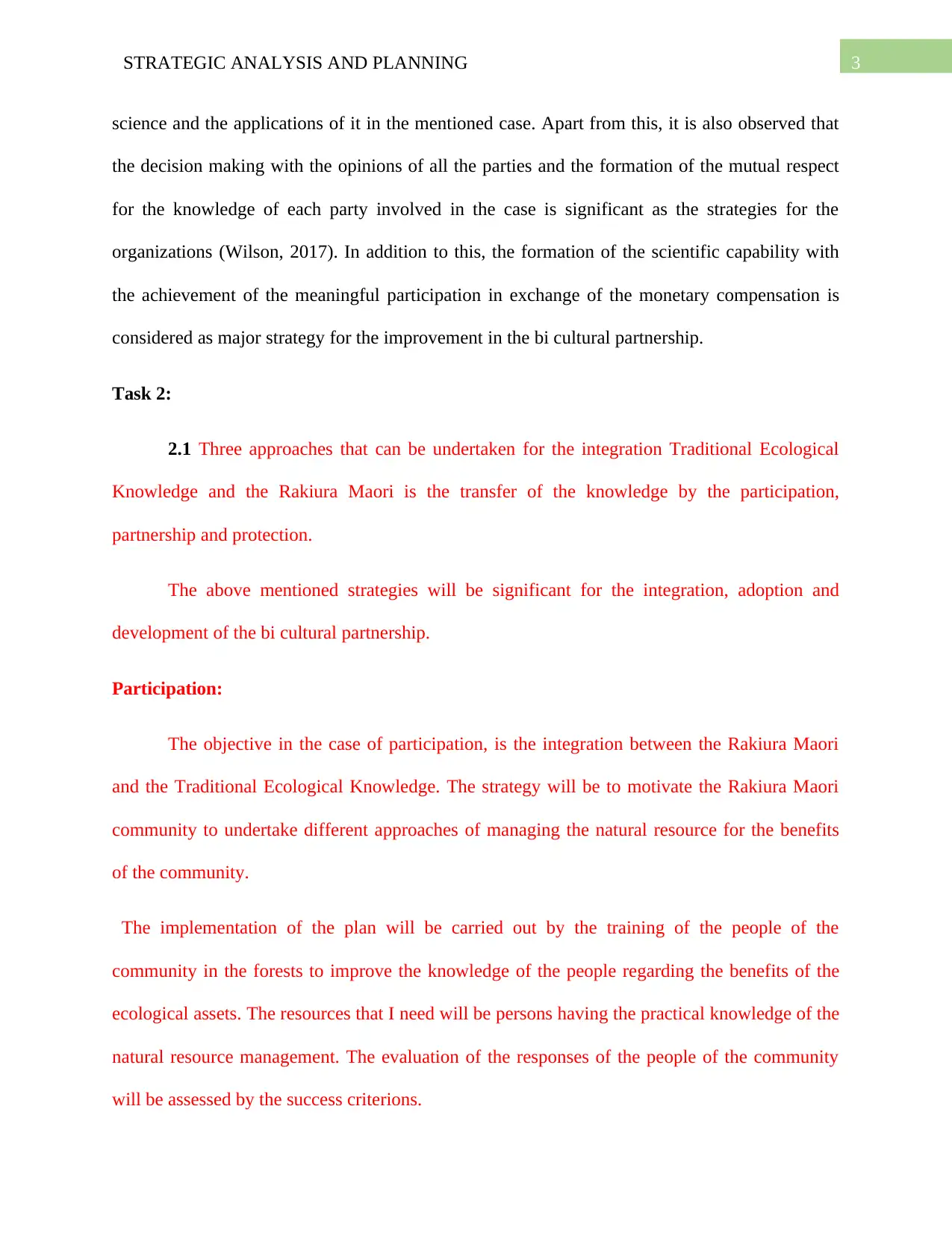
3STRATEGIC ANALYSIS AND PLANNING
science and the applications of it in the mentioned case. Apart from this, it is also observed that
the decision making with the opinions of all the parties and the formation of the mutual respect
for the knowledge of each party involved in the case is significant as the strategies for the
organizations (Wilson, 2017). In addition to this, the formation of the scientific capability with
the achievement of the meaningful participation in exchange of the monetary compensation is
considered as major strategy for the improvement in the bi cultural partnership.
Task 2:
2.1 Three approaches that can be undertaken for the integration Traditional Ecological
Knowledge and the Rakiura Maori is the transfer of the knowledge by the participation,
partnership and protection.
The above mentioned strategies will be significant for the integration, adoption and
development of the bi cultural partnership.
Participation:
The objective in the case of participation, is the integration between the Rakiura Maori
and the Traditional Ecological Knowledge. The strategy will be to motivate the Rakiura Maori
community to undertake different approaches of managing the natural resource for the benefits
of the community.
The implementation of the plan will be carried out by the training of the people of the
community in the forests to improve the knowledge of the people regarding the benefits of the
ecological assets. The resources that I need will be persons having the practical knowledge of the
natural resource management. The evaluation of the responses of the people of the community
will be assessed by the success criterions.
science and the applications of it in the mentioned case. Apart from this, it is also observed that
the decision making with the opinions of all the parties and the formation of the mutual respect
for the knowledge of each party involved in the case is significant as the strategies for the
organizations (Wilson, 2017). In addition to this, the formation of the scientific capability with
the achievement of the meaningful participation in exchange of the monetary compensation is
considered as major strategy for the improvement in the bi cultural partnership.
Task 2:
2.1 Three approaches that can be undertaken for the integration Traditional Ecological
Knowledge and the Rakiura Maori is the transfer of the knowledge by the participation,
partnership and protection.
The above mentioned strategies will be significant for the integration, adoption and
development of the bi cultural partnership.
Participation:
The objective in the case of participation, is the integration between the Rakiura Maori
and the Traditional Ecological Knowledge. The strategy will be to motivate the Rakiura Maori
community to undertake different approaches of managing the natural resource for the benefits
of the community.
The implementation of the plan will be carried out by the training of the people of the
community in the forests to improve the knowledge of the people regarding the benefits of the
ecological assets. The resources that I need will be persons having the practical knowledge of the
natural resource management. The evaluation of the responses of the people of the community
will be assessed by the success criterions.
Paraphrase This Document
Need a fresh take? Get an instant paraphrase of this document with our AI Paraphraser
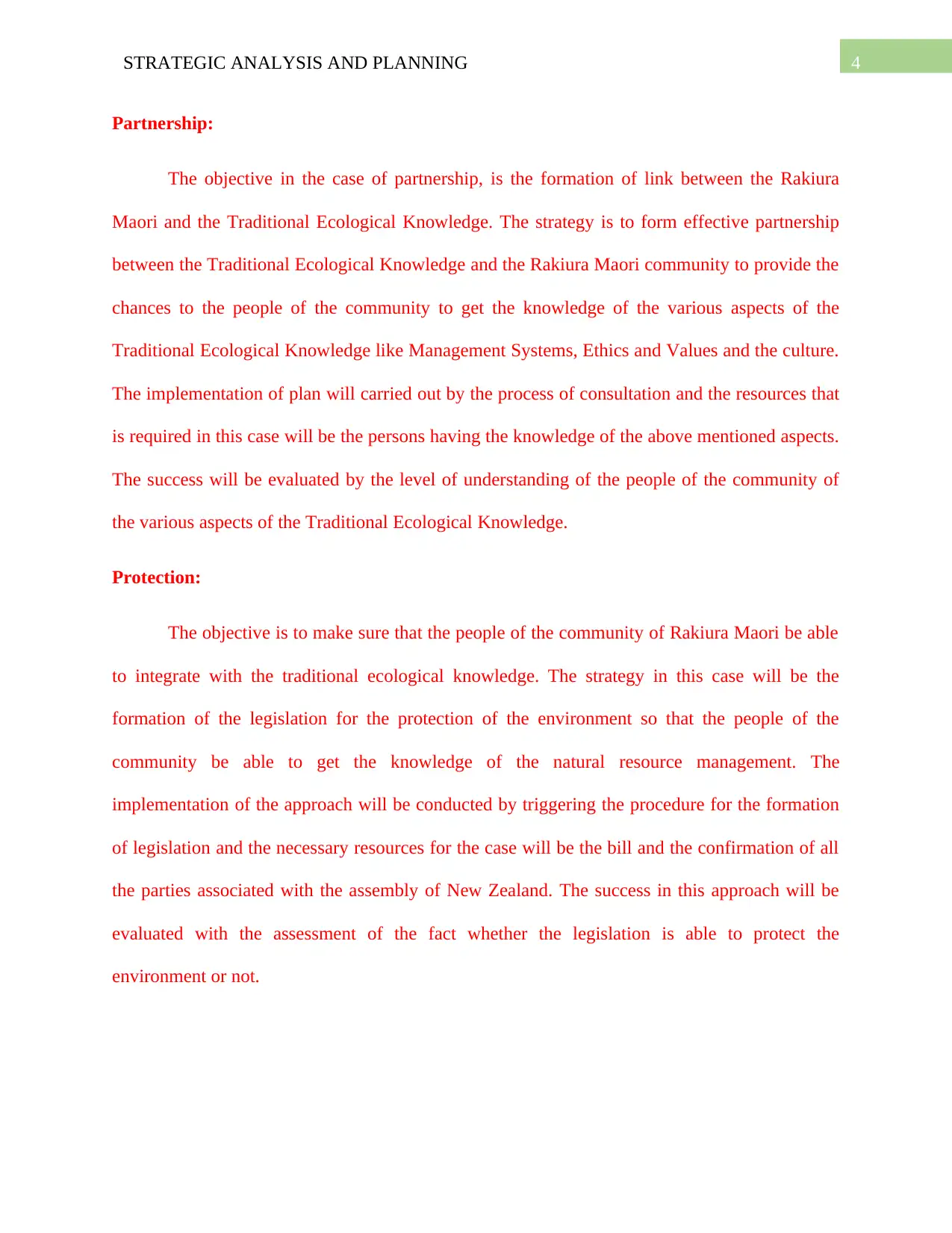
4STRATEGIC ANALYSIS AND PLANNING
Partnership:
The objective in the case of partnership, is the formation of link between the Rakiura
Maori and the Traditional Ecological Knowledge. The strategy is to form effective partnership
between the Traditional Ecological Knowledge and the Rakiura Maori community to provide the
chances to the people of the community to get the knowledge of the various aspects of the
Traditional Ecological Knowledge like Management Systems, Ethics and Values and the culture.
The implementation of plan will carried out by the process of consultation and the resources that
is required in this case will be the persons having the knowledge of the above mentioned aspects.
The success will be evaluated by the level of understanding of the people of the community of
the various aspects of the Traditional Ecological Knowledge.
Protection:
The objective is to make sure that the people of the community of Rakiura Maori be able
to integrate with the traditional ecological knowledge. The strategy in this case will be the
formation of the legislation for the protection of the environment so that the people of the
community be able to get the knowledge of the natural resource management. The
implementation of the approach will be conducted by triggering the procedure for the formation
of legislation and the necessary resources for the case will be the bill and the confirmation of all
the parties associated with the assembly of New Zealand. The success in this approach will be
evaluated with the assessment of the fact whether the legislation is able to protect the
environment or not.
Partnership:
The objective in the case of partnership, is the formation of link between the Rakiura
Maori and the Traditional Ecological Knowledge. The strategy is to form effective partnership
between the Traditional Ecological Knowledge and the Rakiura Maori community to provide the
chances to the people of the community to get the knowledge of the various aspects of the
Traditional Ecological Knowledge like Management Systems, Ethics and Values and the culture.
The implementation of plan will carried out by the process of consultation and the resources that
is required in this case will be the persons having the knowledge of the above mentioned aspects.
The success will be evaluated by the level of understanding of the people of the community of
the various aspects of the Traditional Ecological Knowledge.
Protection:
The objective is to make sure that the people of the community of Rakiura Maori be able
to integrate with the traditional ecological knowledge. The strategy in this case will be the
formation of the legislation for the protection of the environment so that the people of the
community be able to get the knowledge of the natural resource management. The
implementation of the approach will be conducted by triggering the procedure for the formation
of legislation and the necessary resources for the case will be the bill and the confirmation of all
the parties associated with the assembly of New Zealand. The success in this approach will be
evaluated with the assessment of the fact whether the legislation is able to protect the
environment or not.
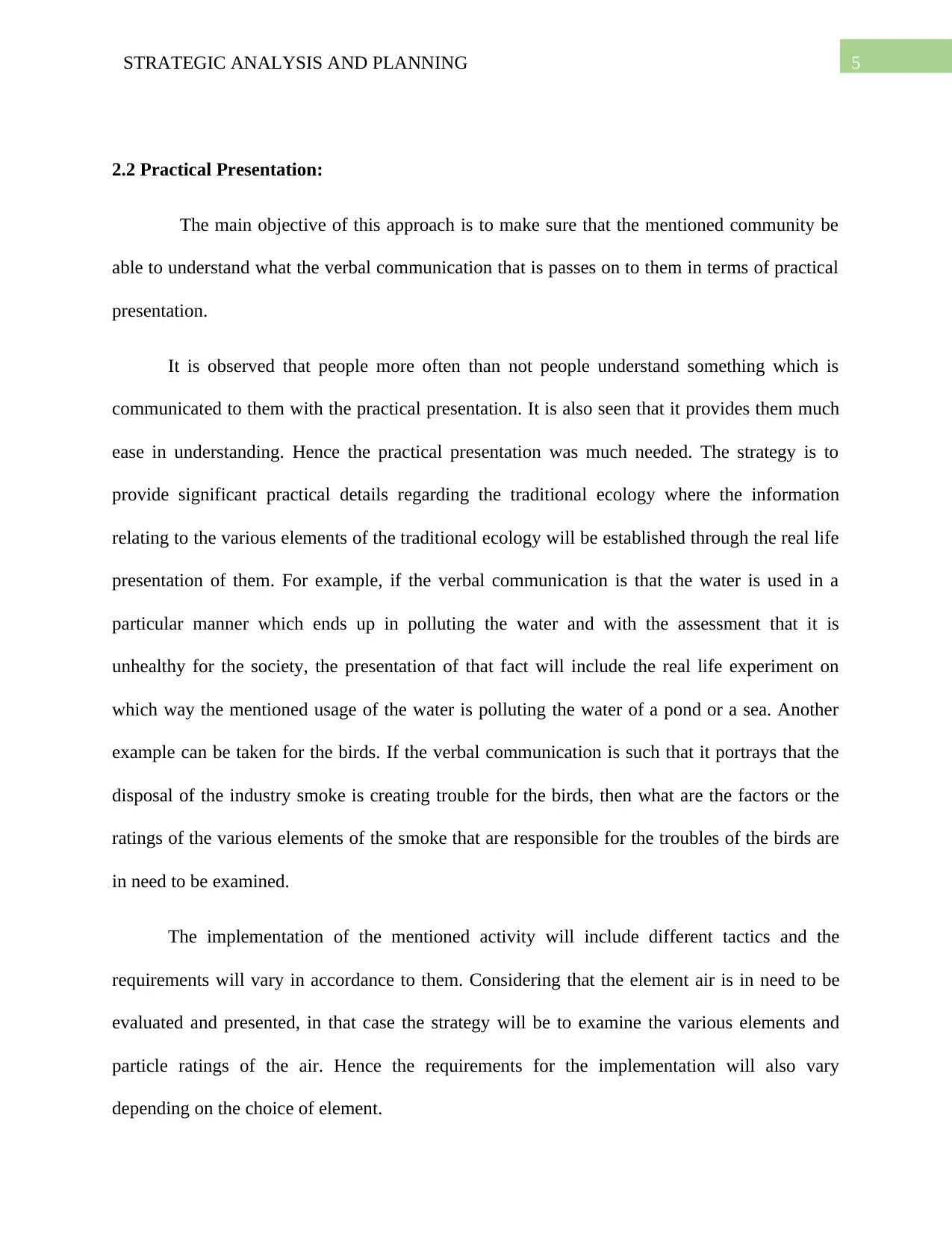
5STRATEGIC ANALYSIS AND PLANNING
2.2 Practical Presentation:
The main objective of this approach is to make sure that the mentioned community be
able to understand what the verbal communication that is passes on to them in terms of practical
presentation.
It is observed that people more often than not people understand something which is
communicated to them with the practical presentation. It is also seen that it provides them much
ease in understanding. Hence the practical presentation was much needed. The strategy is to
provide significant practical details regarding the traditional ecology where the information
relating to the various elements of the traditional ecology will be established through the real life
presentation of them. For example, if the verbal communication is that the water is used in a
particular manner which ends up in polluting the water and with the assessment that it is
unhealthy for the society, the presentation of that fact will include the real life experiment on
which way the mentioned usage of the water is polluting the water of a pond or a sea. Another
example can be taken for the birds. If the verbal communication is such that it portrays that the
disposal of the industry smoke is creating trouble for the birds, then what are the factors or the
ratings of the various elements of the smoke that are responsible for the troubles of the birds are
in need to be examined.
The implementation of the mentioned activity will include different tactics and the
requirements will vary in accordance to them. Considering that the element air is in need to be
evaluated and presented, in that case the strategy will be to examine the various elements and
particle ratings of the air. Hence the requirements for the implementation will also vary
depending on the choice of element.
2.2 Practical Presentation:
The main objective of this approach is to make sure that the mentioned community be
able to understand what the verbal communication that is passes on to them in terms of practical
presentation.
It is observed that people more often than not people understand something which is
communicated to them with the practical presentation. It is also seen that it provides them much
ease in understanding. Hence the practical presentation was much needed. The strategy is to
provide significant practical details regarding the traditional ecology where the information
relating to the various elements of the traditional ecology will be established through the real life
presentation of them. For example, if the verbal communication is that the water is used in a
particular manner which ends up in polluting the water and with the assessment that it is
unhealthy for the society, the presentation of that fact will include the real life experiment on
which way the mentioned usage of the water is polluting the water of a pond or a sea. Another
example can be taken for the birds. If the verbal communication is such that it portrays that the
disposal of the industry smoke is creating trouble for the birds, then what are the factors or the
ratings of the various elements of the smoke that are responsible for the troubles of the birds are
in need to be examined.
The implementation of the mentioned activity will include different tactics and the
requirements will vary in accordance to them. Considering that the element air is in need to be
evaluated and presented, in that case the strategy will be to examine the various elements and
particle ratings of the air. Hence the requirements for the implementation will also vary
depending on the choice of element.
⊘ This is a preview!⊘
Do you want full access?
Subscribe today to unlock all pages.

Trusted by 1+ million students worldwide
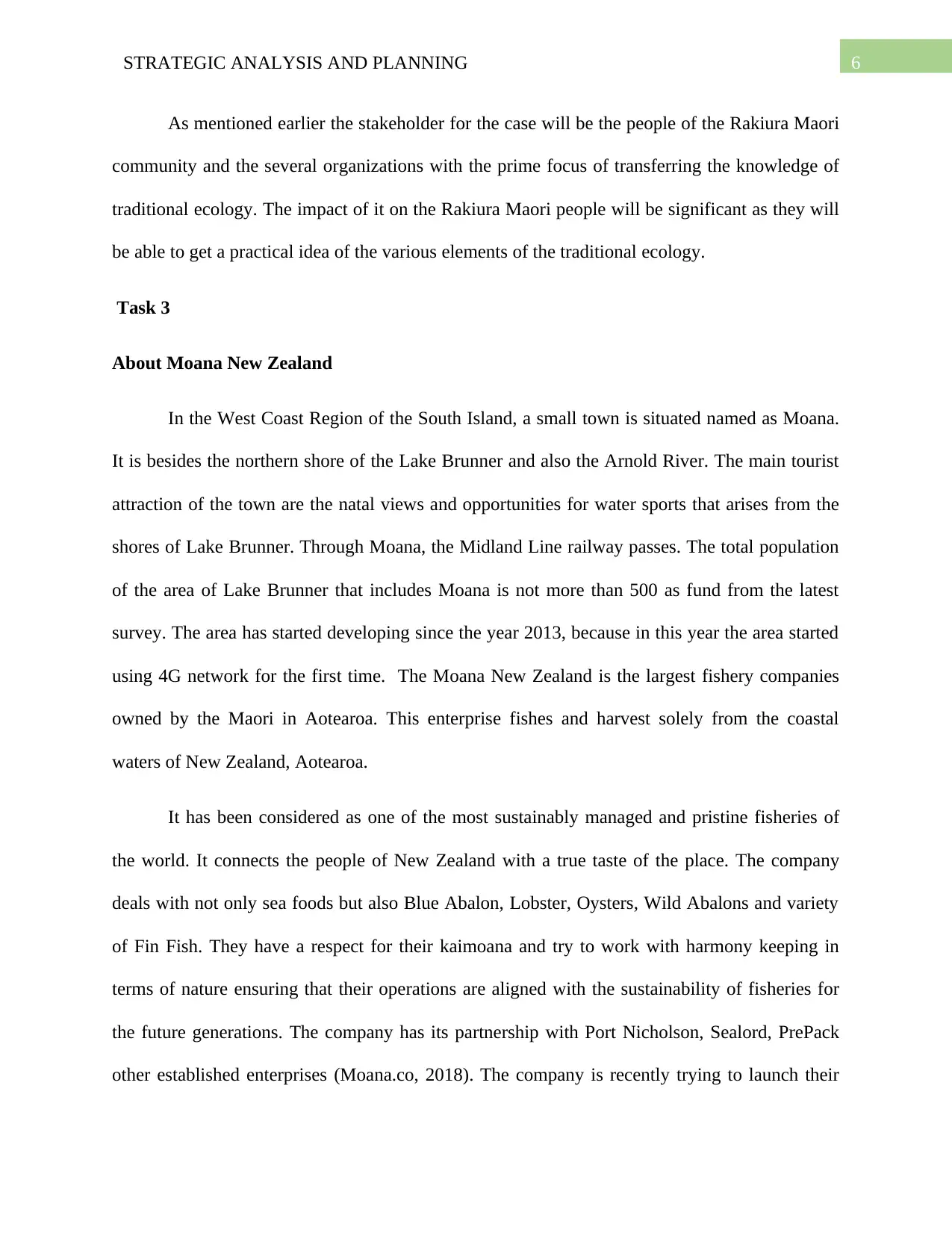
6STRATEGIC ANALYSIS AND PLANNING
As mentioned earlier the stakeholder for the case will be the people of the Rakiura Maori
community and the several organizations with the prime focus of transferring the knowledge of
traditional ecology. The impact of it on the Rakiura Maori people will be significant as they will
be able to get a practical idea of the various elements of the traditional ecology.
Task 3
About Moana New Zealand
In the West Coast Region of the South Island, a small town is situated named as Moana.
It is besides the northern shore of the Lake Brunner and also the Arnold River. The main tourist
attraction of the town are the natal views and opportunities for water sports that arises from the
shores of Lake Brunner. Through Moana, the Midland Line railway passes. The total population
of the area of Lake Brunner that includes Moana is not more than 500 as fund from the latest
survey. The area has started developing since the year 2013, because in this year the area started
using 4G network for the first time. The Moana New Zealand is the largest fishery companies
owned by the Maori in Aotearoa. This enterprise fishes and harvest solely from the coastal
waters of New Zealand, Aotearoa.
It has been considered as one of the most sustainably managed and pristine fisheries of
the world. It connects the people of New Zealand with a true taste of the place. The company
deals with not only sea foods but also Blue Abalon, Lobster, Oysters, Wild Abalons and variety
of Fin Fish. They have a respect for their kaimoana and try to work with harmony keeping in
terms of nature ensuring that their operations are aligned with the sustainability of fisheries for
the future generations. The company has its partnership with Port Nicholson, Sealord, PrePack
other established enterprises (Moana.co, 2018). The company is recently trying to launch their
As mentioned earlier the stakeholder for the case will be the people of the Rakiura Maori
community and the several organizations with the prime focus of transferring the knowledge of
traditional ecology. The impact of it on the Rakiura Maori people will be significant as they will
be able to get a practical idea of the various elements of the traditional ecology.
Task 3
About Moana New Zealand
In the West Coast Region of the South Island, a small town is situated named as Moana.
It is besides the northern shore of the Lake Brunner and also the Arnold River. The main tourist
attraction of the town are the natal views and opportunities for water sports that arises from the
shores of Lake Brunner. Through Moana, the Midland Line railway passes. The total population
of the area of Lake Brunner that includes Moana is not more than 500 as fund from the latest
survey. The area has started developing since the year 2013, because in this year the area started
using 4G network for the first time. The Moana New Zealand is the largest fishery companies
owned by the Maori in Aotearoa. This enterprise fishes and harvest solely from the coastal
waters of New Zealand, Aotearoa.
It has been considered as one of the most sustainably managed and pristine fisheries of
the world. It connects the people of New Zealand with a true taste of the place. The company
deals with not only sea foods but also Blue Abalon, Lobster, Oysters, Wild Abalons and variety
of Fin Fish. They have a respect for their kaimoana and try to work with harmony keeping in
terms of nature ensuring that their operations are aligned with the sustainability of fisheries for
the future generations. The company has its partnership with Port Nicholson, Sealord, PrePack
other established enterprises (Moana.co, 2018). The company is recently trying to launch their
Paraphrase This Document
Need a fresh take? Get an instant paraphrase of this document with our AI Paraphraser
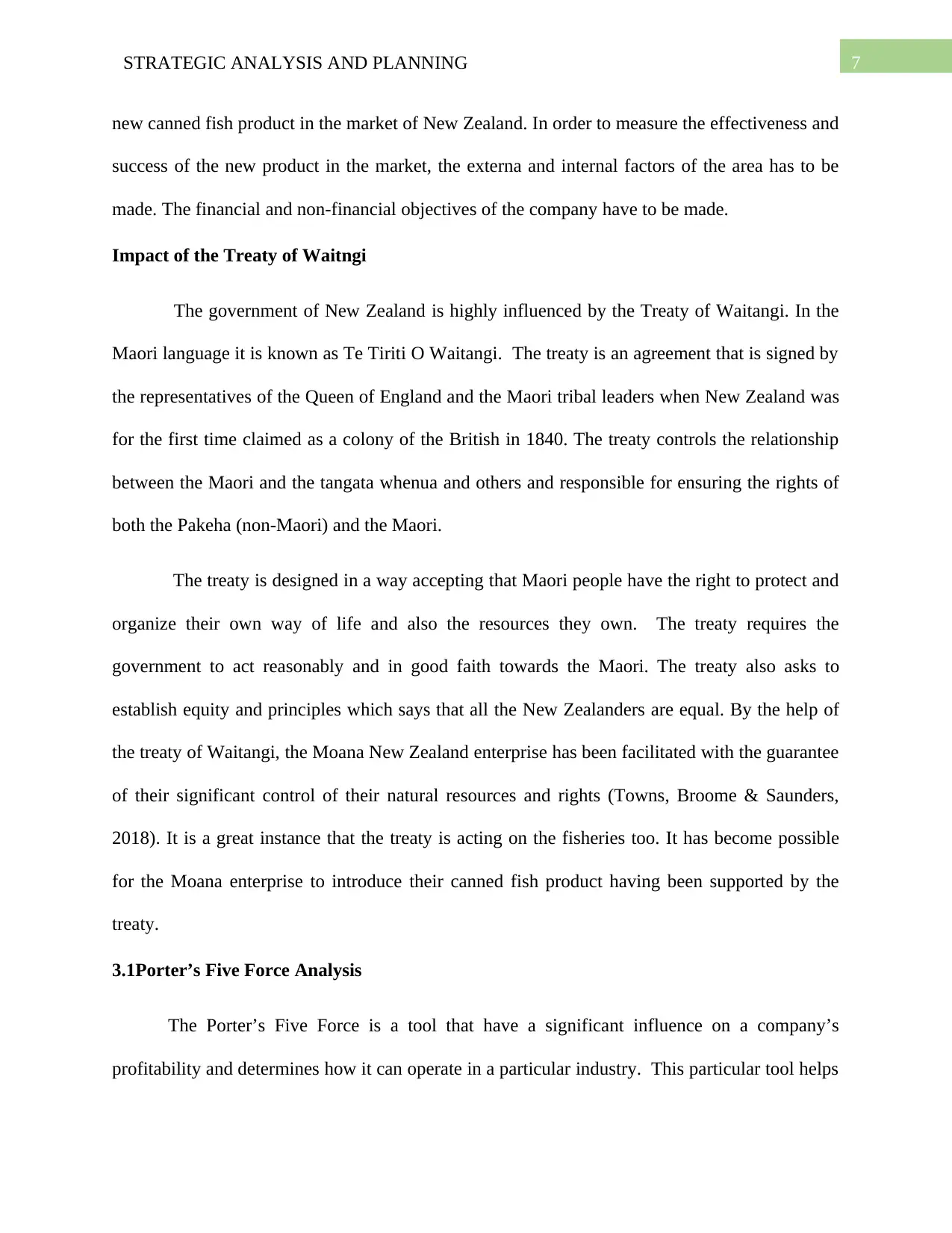
7STRATEGIC ANALYSIS AND PLANNING
new canned fish product in the market of New Zealand. In order to measure the effectiveness and
success of the new product in the market, the externa and internal factors of the area has to be
made. The financial and non-financial objectives of the company have to be made.
Impact of the Treaty of Waitngi
The government of New Zealand is highly influenced by the Treaty of Waitangi. In the
Maori language it is known as Te Tiriti O Waitangi. The treaty is an agreement that is signed by
the representatives of the Queen of England and the Maori tribal leaders when New Zealand was
for the first time claimed as a colony of the British in 1840. The treaty controls the relationship
between the Maori and the tangata whenua and others and responsible for ensuring the rights of
both the Pakeha (non-Maori) and the Maori.
The treaty is designed in a way accepting that Maori people have the right to protect and
organize their own way of life and also the resources they own. The treaty requires the
government to act reasonably and in good faith towards the Maori. The treaty also asks to
establish equity and principles which says that all the New Zealanders are equal. By the help of
the treaty of Waitangi, the Moana New Zealand enterprise has been facilitated with the guarantee
of their significant control of their natural resources and rights (Towns, Broome & Saunders,
2018). It is a great instance that the treaty is acting on the fisheries too. It has become possible
for the Moana enterprise to introduce their canned fish product having been supported by the
treaty.
3.1Porter’s Five Force Analysis
The Porter’s Five Force is a tool that have a significant influence on a company’s
profitability and determines how it can operate in a particular industry. This particular tool helps
new canned fish product in the market of New Zealand. In order to measure the effectiveness and
success of the new product in the market, the externa and internal factors of the area has to be
made. The financial and non-financial objectives of the company have to be made.
Impact of the Treaty of Waitngi
The government of New Zealand is highly influenced by the Treaty of Waitangi. In the
Maori language it is known as Te Tiriti O Waitangi. The treaty is an agreement that is signed by
the representatives of the Queen of England and the Maori tribal leaders when New Zealand was
for the first time claimed as a colony of the British in 1840. The treaty controls the relationship
between the Maori and the tangata whenua and others and responsible for ensuring the rights of
both the Pakeha (non-Maori) and the Maori.
The treaty is designed in a way accepting that Maori people have the right to protect and
organize their own way of life and also the resources they own. The treaty requires the
government to act reasonably and in good faith towards the Maori. The treaty also asks to
establish equity and principles which says that all the New Zealanders are equal. By the help of
the treaty of Waitangi, the Moana New Zealand enterprise has been facilitated with the guarantee
of their significant control of their natural resources and rights (Towns, Broome & Saunders,
2018). It is a great instance that the treaty is acting on the fisheries too. It has become possible
for the Moana enterprise to introduce their canned fish product having been supported by the
treaty.
3.1Porter’s Five Force Analysis
The Porter’s Five Force is a tool that have a significant influence on a company’s
profitability and determines how it can operate in a particular industry. This particular tool helps
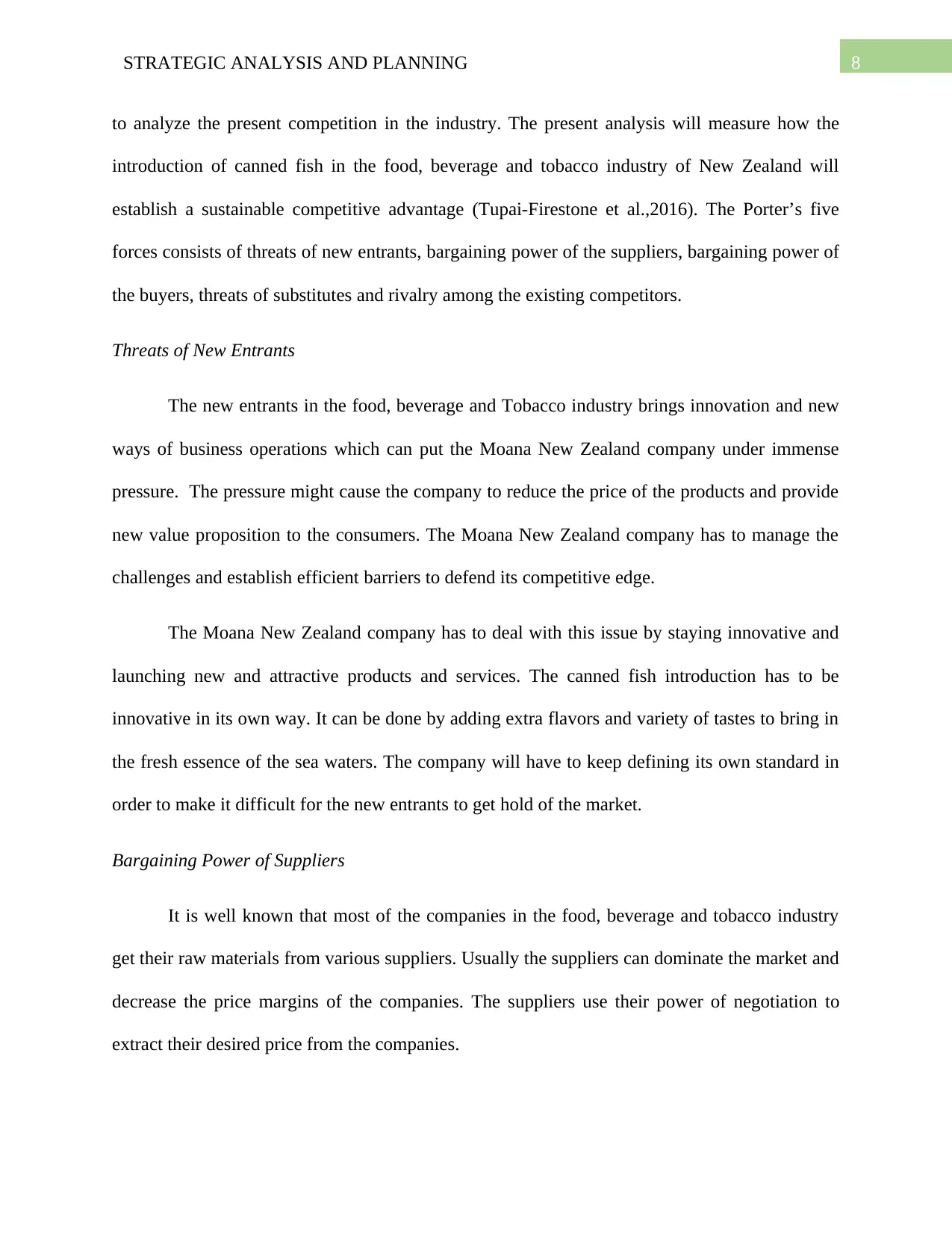
8STRATEGIC ANALYSIS AND PLANNING
to analyze the present competition in the industry. The present analysis will measure how the
introduction of canned fish in the food, beverage and tobacco industry of New Zealand will
establish a sustainable competitive advantage (Tupai-Firestone et al.,2016). The Porter’s five
forces consists of threats of new entrants, bargaining power of the suppliers, bargaining power of
the buyers, threats of substitutes and rivalry among the existing competitors.
Threats of New Entrants
The new entrants in the food, beverage and Tobacco industry brings innovation and new
ways of business operations which can put the Moana New Zealand company under immense
pressure. The pressure might cause the company to reduce the price of the products and provide
new value proposition to the consumers. The Moana New Zealand company has to manage the
challenges and establish efficient barriers to defend its competitive edge.
The Moana New Zealand company has to deal with this issue by staying innovative and
launching new and attractive products and services. The canned fish introduction has to be
innovative in its own way. It can be done by adding extra flavors and variety of tastes to bring in
the fresh essence of the sea waters. The company will have to keep defining its own standard in
order to make it difficult for the new entrants to get hold of the market.
Bargaining Power of Suppliers
It is well known that most of the companies in the food, beverage and tobacco industry
get their raw materials from various suppliers. Usually the suppliers can dominate the market and
decrease the price margins of the companies. The suppliers use their power of negotiation to
extract their desired price from the companies.
to analyze the present competition in the industry. The present analysis will measure how the
introduction of canned fish in the food, beverage and tobacco industry of New Zealand will
establish a sustainable competitive advantage (Tupai-Firestone et al.,2016). The Porter’s five
forces consists of threats of new entrants, bargaining power of the suppliers, bargaining power of
the buyers, threats of substitutes and rivalry among the existing competitors.
Threats of New Entrants
The new entrants in the food, beverage and Tobacco industry brings innovation and new
ways of business operations which can put the Moana New Zealand company under immense
pressure. The pressure might cause the company to reduce the price of the products and provide
new value proposition to the consumers. The Moana New Zealand company has to manage the
challenges and establish efficient barriers to defend its competitive edge.
The Moana New Zealand company has to deal with this issue by staying innovative and
launching new and attractive products and services. The canned fish introduction has to be
innovative in its own way. It can be done by adding extra flavors and variety of tastes to bring in
the fresh essence of the sea waters. The company will have to keep defining its own standard in
order to make it difficult for the new entrants to get hold of the market.
Bargaining Power of Suppliers
It is well known that most of the companies in the food, beverage and tobacco industry
get their raw materials from various suppliers. Usually the suppliers can dominate the market and
decrease the price margins of the companies. The suppliers use their power of negotiation to
extract their desired price from the companies.
⊘ This is a preview!⊘
Do you want full access?
Subscribe today to unlock all pages.

Trusted by 1+ million students worldwide
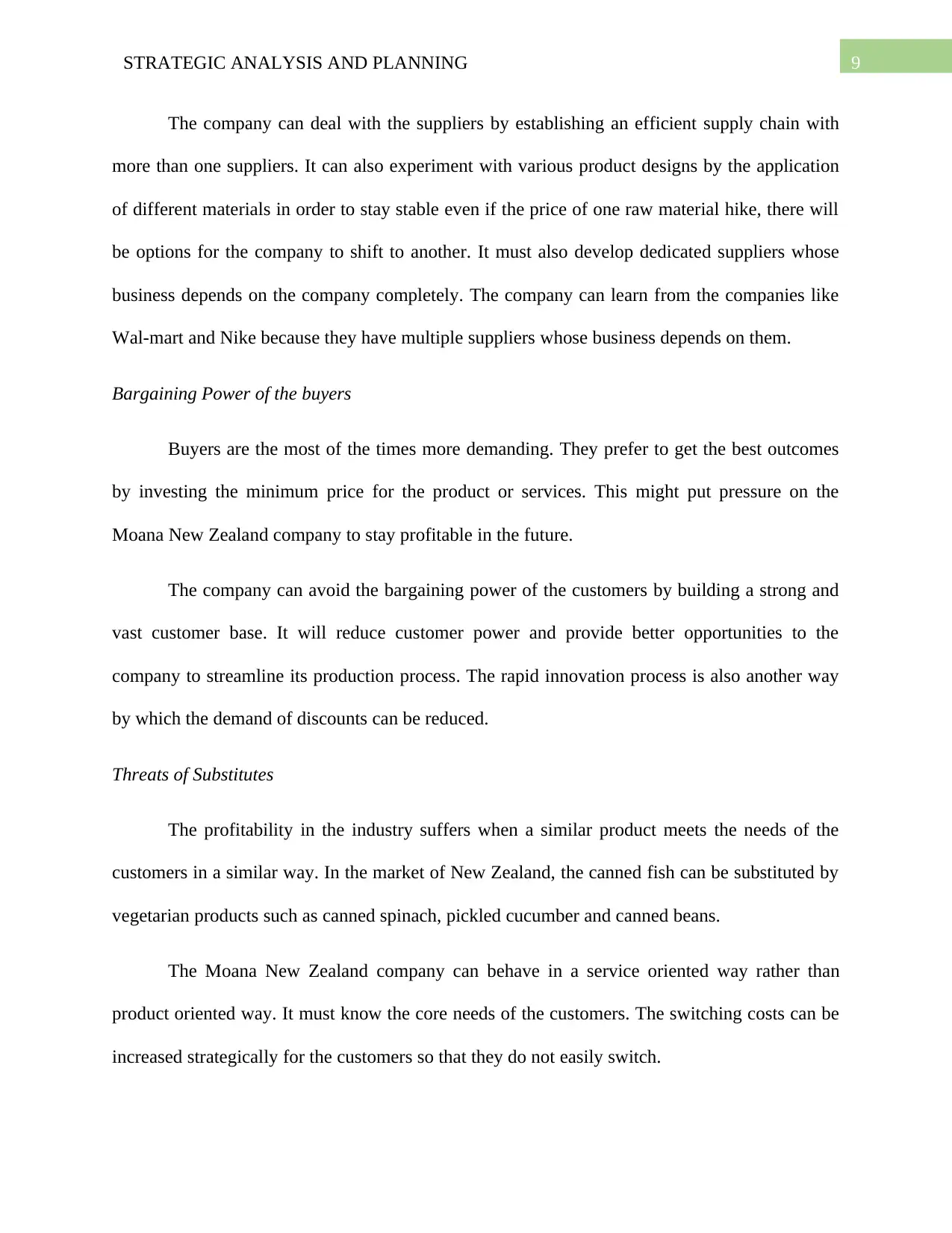
9STRATEGIC ANALYSIS AND PLANNING
The company can deal with the suppliers by establishing an efficient supply chain with
more than one suppliers. It can also experiment with various product designs by the application
of different materials in order to stay stable even if the price of one raw material hike, there will
be options for the company to shift to another. It must also develop dedicated suppliers whose
business depends on the company completely. The company can learn from the companies like
Wal-mart and Nike because they have multiple suppliers whose business depends on them.
Bargaining Power of the buyers
Buyers are the most of the times more demanding. They prefer to get the best outcomes
by investing the minimum price for the product or services. This might put pressure on the
Moana New Zealand company to stay profitable in the future.
The company can avoid the bargaining power of the customers by building a strong and
vast customer base. It will reduce customer power and provide better opportunities to the
company to streamline its production process. The rapid innovation process is also another way
by which the demand of discounts can be reduced.
Threats of Substitutes
The profitability in the industry suffers when a similar product meets the needs of the
customers in a similar way. In the market of New Zealand, the canned fish can be substituted by
vegetarian products such as canned spinach, pickled cucumber and canned beans.
The Moana New Zealand company can behave in a service oriented way rather than
product oriented way. It must know the core needs of the customers. The switching costs can be
increased strategically for the customers so that they do not easily switch.
The company can deal with the suppliers by establishing an efficient supply chain with
more than one suppliers. It can also experiment with various product designs by the application
of different materials in order to stay stable even if the price of one raw material hike, there will
be options for the company to shift to another. It must also develop dedicated suppliers whose
business depends on the company completely. The company can learn from the companies like
Wal-mart and Nike because they have multiple suppliers whose business depends on them.
Bargaining Power of the buyers
Buyers are the most of the times more demanding. They prefer to get the best outcomes
by investing the minimum price for the product or services. This might put pressure on the
Moana New Zealand company to stay profitable in the future.
The company can avoid the bargaining power of the customers by building a strong and
vast customer base. It will reduce customer power and provide better opportunities to the
company to streamline its production process. The rapid innovation process is also another way
by which the demand of discounts can be reduced.
Threats of Substitutes
The profitability in the industry suffers when a similar product meets the needs of the
customers in a similar way. In the market of New Zealand, the canned fish can be substituted by
vegetarian products such as canned spinach, pickled cucumber and canned beans.
The Moana New Zealand company can behave in a service oriented way rather than
product oriented way. It must know the core needs of the customers. The switching costs can be
increased strategically for the customers so that they do not easily switch.
Paraphrase This Document
Need a fresh take? Get an instant paraphrase of this document with our AI Paraphraser
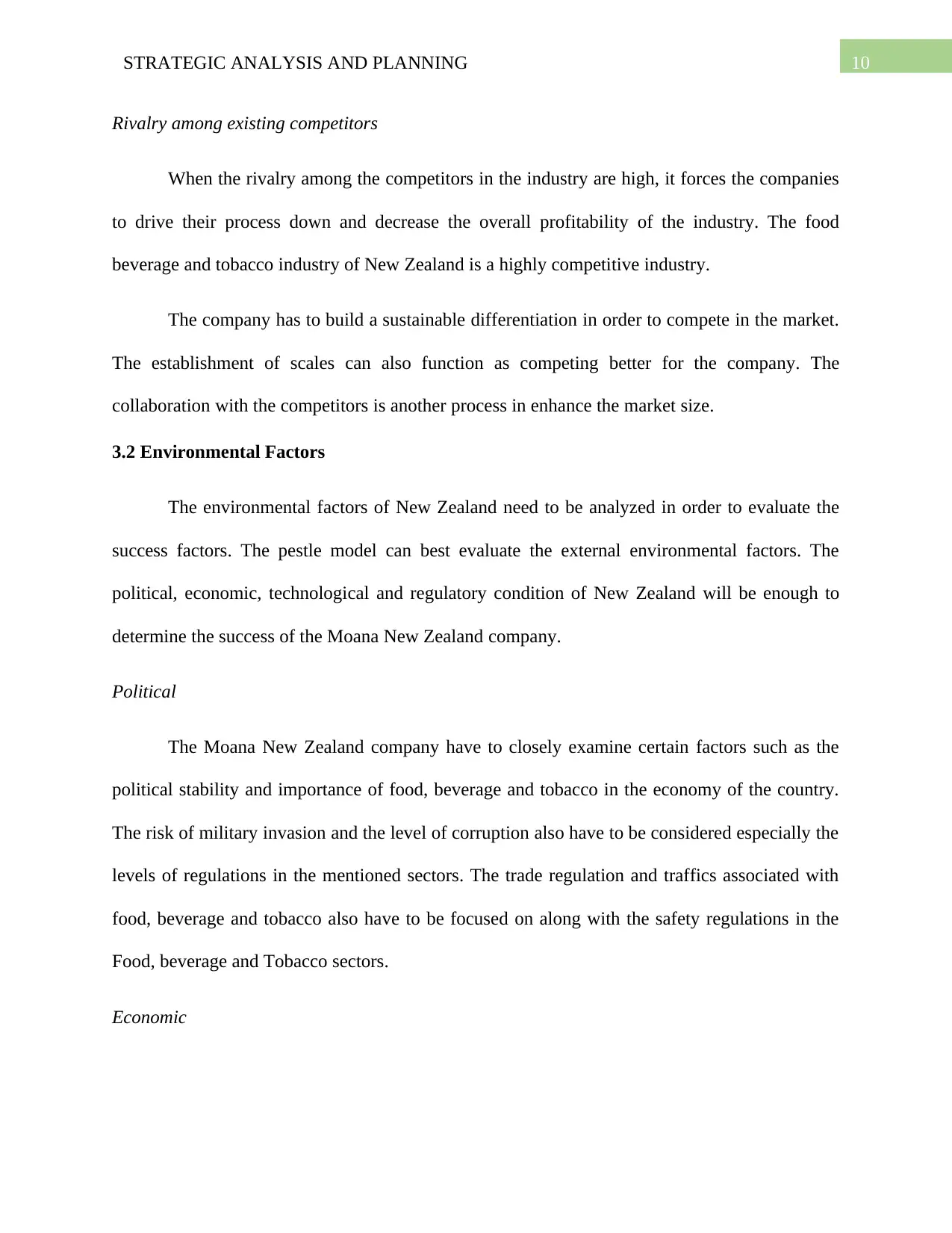
10STRATEGIC ANALYSIS AND PLANNING
Rivalry among existing competitors
When the rivalry among the competitors in the industry are high, it forces the companies
to drive their process down and decrease the overall profitability of the industry. The food
beverage and tobacco industry of New Zealand is a highly competitive industry.
The company has to build a sustainable differentiation in order to compete in the market.
The establishment of scales can also function as competing better for the company. The
collaboration with the competitors is another process in enhance the market size.
3.2 Environmental Factors
The environmental factors of New Zealand need to be analyzed in order to evaluate the
success factors. The pestle model can best evaluate the external environmental factors. The
political, economic, technological and regulatory condition of New Zealand will be enough to
determine the success of the Moana New Zealand company.
Political
The Moana New Zealand company have to closely examine certain factors such as the
political stability and importance of food, beverage and tobacco in the economy of the country.
The risk of military invasion and the level of corruption also have to be considered especially the
levels of regulations in the mentioned sectors. The trade regulation and traffics associated with
food, beverage and tobacco also have to be focused on along with the safety regulations in the
Food, beverage and Tobacco sectors.
Economic
Rivalry among existing competitors
When the rivalry among the competitors in the industry are high, it forces the companies
to drive their process down and decrease the overall profitability of the industry. The food
beverage and tobacco industry of New Zealand is a highly competitive industry.
The company has to build a sustainable differentiation in order to compete in the market.
The establishment of scales can also function as competing better for the company. The
collaboration with the competitors is another process in enhance the market size.
3.2 Environmental Factors
The environmental factors of New Zealand need to be analyzed in order to evaluate the
success factors. The pestle model can best evaluate the external environmental factors. The
political, economic, technological and regulatory condition of New Zealand will be enough to
determine the success of the Moana New Zealand company.
Political
The Moana New Zealand company have to closely examine certain factors such as the
political stability and importance of food, beverage and tobacco in the economy of the country.
The risk of military invasion and the level of corruption also have to be considered especially the
levels of regulations in the mentioned sectors. The trade regulation and traffics associated with
food, beverage and tobacco also have to be focused on along with the safety regulations in the
Food, beverage and Tobacco sectors.
Economic
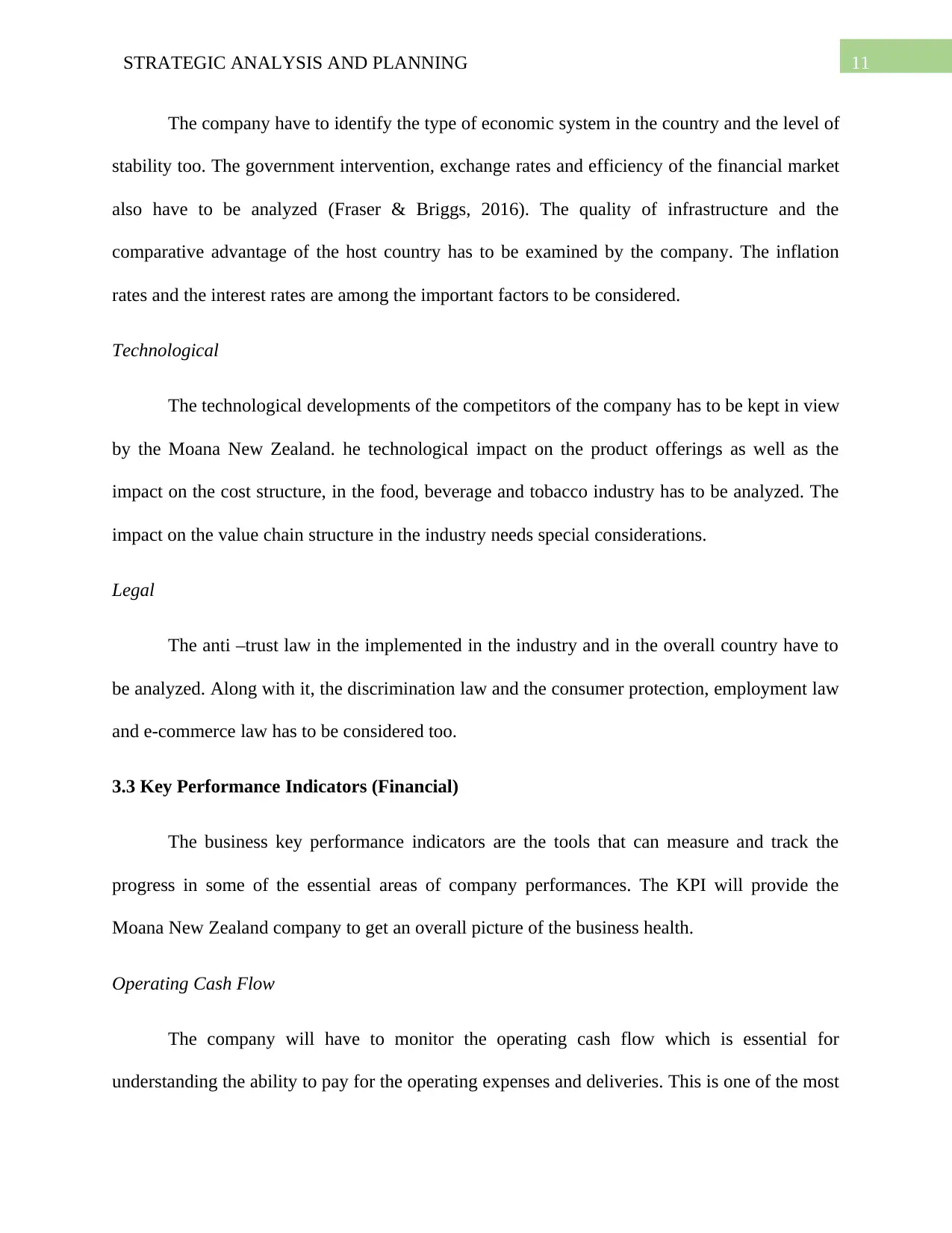
11STRATEGIC ANALYSIS AND PLANNING
The company have to identify the type of economic system in the country and the level of
stability too. The government intervention, exchange rates and efficiency of the financial market
also have to be analyzed (Fraser & Briggs, 2016). The quality of infrastructure and the
comparative advantage of the host country has to be examined by the company. The inflation
rates and the interest rates are among the important factors to be considered.
Technological
The technological developments of the competitors of the company has to be kept in view
by the Moana New Zealand. he technological impact on the product offerings as well as the
impact on the cost structure, in the food, beverage and tobacco industry has to be analyzed. The
impact on the value chain structure in the industry needs special considerations.
Legal
The anti –trust law in the implemented in the industry and in the overall country have to
be analyzed. Along with it, the discrimination law and the consumer protection, employment law
and e-commerce law has to be considered too.
3.3 Key Performance Indicators (Financial)
The business key performance indicators are the tools that can measure and track the
progress in some of the essential areas of company performances. The KPI will provide the
Moana New Zealand company to get an overall picture of the business health.
Operating Cash Flow
The company will have to monitor the operating cash flow which is essential for
understanding the ability to pay for the operating expenses and deliveries. This is one of the most
The company have to identify the type of economic system in the country and the level of
stability too. The government intervention, exchange rates and efficiency of the financial market
also have to be analyzed (Fraser & Briggs, 2016). The quality of infrastructure and the
comparative advantage of the host country has to be examined by the company. The inflation
rates and the interest rates are among the important factors to be considered.
Technological
The technological developments of the competitors of the company has to be kept in view
by the Moana New Zealand. he technological impact on the product offerings as well as the
impact on the cost structure, in the food, beverage and tobacco industry has to be analyzed. The
impact on the value chain structure in the industry needs special considerations.
Legal
The anti –trust law in the implemented in the industry and in the overall country have to
be analyzed. Along with it, the discrimination law and the consumer protection, employment law
and e-commerce law has to be considered too.
3.3 Key Performance Indicators (Financial)
The business key performance indicators are the tools that can measure and track the
progress in some of the essential areas of company performances. The KPI will provide the
Moana New Zealand company to get an overall picture of the business health.
Operating Cash Flow
The company will have to monitor the operating cash flow which is essential for
understanding the ability to pay for the operating expenses and deliveries. This is one of the most
⊘ This is a preview!⊘
Do you want full access?
Subscribe today to unlock all pages.

Trusted by 1+ million students worldwide
1 out of 15
Related Documents
Your All-in-One AI-Powered Toolkit for Academic Success.
+13062052269
info@desklib.com
Available 24*7 on WhatsApp / Email
![[object Object]](/_next/static/media/star-bottom.7253800d.svg)
Unlock your academic potential
Copyright © 2020–2025 A2Z Services. All Rights Reserved. Developed and managed by ZUCOL.





